Student author | @shaofaye123
Guidance teacher | @CryptoScott_ETH
First release date | 2024.5.31

- Memes spread through imitation. Any piece of information that can be replicated through imitation can be called a meme; the various forms of information spread are different types of memes, such as music, ideas, or styles. The spread of memes conforms to the theory of life cycles and is applicable to the model of infectious diseases, but it is still difficult to quantify the standards of dominant memes.
- MEMEs present themselves in different forms in each cycle, with different characteristics and mechanisms as the cycle changes. To a certain extent, MEMEs can reflect the attitudes of investors and market hotspots at different times, including prospects for new technologies and narrative directions.
- The current bull market MEMEs wave is influenced by society, psychology, economics, and technology. At this stage, types of MEMEs can be roughly classified from the perspectives of mechanism innovation, market narratives, market sentiment, meme culture, celebrity effects, and hot spot imitation. The gameplay mechanisms are diverse, and rational strategies need to be established to profit.
- The future of MEMEs is highly controversial, with differing opinions from institutional investors, retail investors, and KOLs. MEMEs should be interesting and meaningful, and should not become speculative tools.

From Ethereum to Solana, MEMEs have never lacked in creating myths. According to a report from CoinGecko, MEMEs were the most profitable cryptocurrency in the first quarter of 2024, with the highest average return rate of the top tokens reaching 1312.6%.
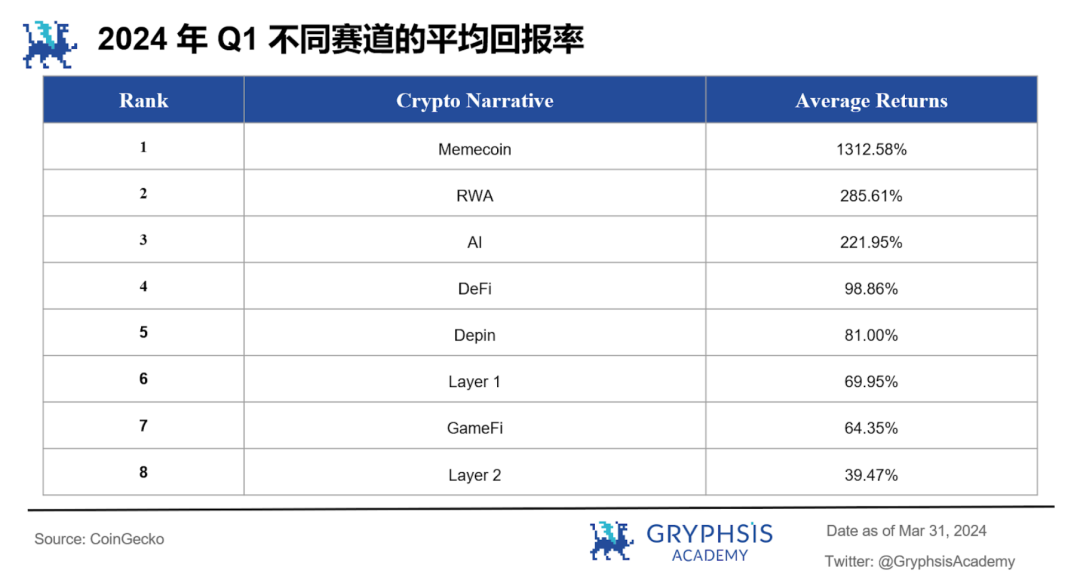
PANews has previously analyzed the investment returns of MEMEs from the perspective of the Kelly formula. By calculating the daily issuance and success rate on the Ethereum and Solana chains, it was found that their success rates are extremely low, with Ethereum at 3.28% and Solana even lower at only 1.6%, ultimately leading to players always losing in the end.
MEMEs are a high-risk, high-return investment game. How does it attract the public to participate and how does it spread? Where does the future of value coins vs. MEMEs lie?


"When we leave this world, only two things will remain: genes and MEMEs."
——Richard Dawkins
MEME, also known as a meme, mi, mimeme, mimo, or meme, is an abbreviation of the word "mimeme," derived from the ancient Greek word μíμημα. Its original meaning is to imitate or replicate. The concept of MEMEs originally came from the book "The Selfish Gene" by the British evolutionary biologist Richard Dawkins. He described memes as "cultural units of imitation that self-replicate in the meme pool through… (in a broader sense) imitation."
The concept of memes has had a biological analogy since its inception. This analogy places memes on equal footing with genes (both can self-replicate, inherit, mutate, and respond to selective pressures), giving rise to a new discipline—memetics.
There are various dimensions for classifying memes. From the perspective of benefits, they can be divided into beneficial memes and harmful memes; based on their forms, they can be classified as complex memes and simple memes; from an evolutionary perspective, they can be categorized as symbiotic memes and parasitic memes; and based on their replicative ability, they can be divided into dominant memes and recessive memes.
Currently, there are various interpretations of the concept of memes, and the most widely accepted definition is based on the synthesis of Dawkins and Blackmore, which states that memes spread through imitation; any piece of information that can be replicated through imitation can be called a meme; the various forms of information spread are different types of memes, such as music, ideas, or styles.
The definition of MEMEs varies even more. Different people have vastly different views on MEMEs. In the eyes of Web2, BTC may be the biggest MEMEs. However, in the eyes of mainstream coin players, even altcoins may be considered MEMEs. But summarizing their commonalities, MEMEs refer to tokens that, in the eyes of investors, have no practical use, exist solely for speculative trading, and are priced based on market sentiment.

The meaning of "imitated and spread" implies the iterative nature of memes; without the act of spreading, memes cannot exist.
It is evident that the successful replication of MEMEs depends on their spread. How do MEMEs spread?
A meme goes through the stages of expression (E), transmission (T), assimilation by the recipient (A), and retention in the memory system of the recipient's brain (R). After completing these four steps, the meme finds a new host, completing one lifecycle of meme propagation.
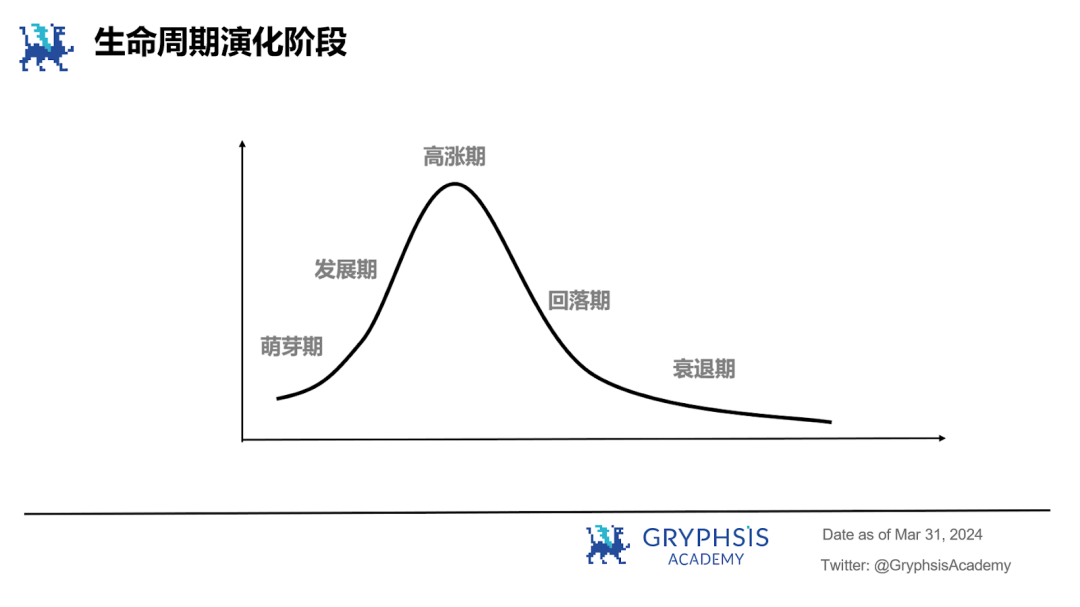
Its mode of transmission is similar to that of a virus, and the transmission path can be well revealed through an infectious disease model. The spread of MEMEs is usually deconstructed from the SIR model, with a decrease in susceptible individuals, an increase in recovered individuals, and a subsequent increase and decrease in infectious individuals, resulting in a peak. This peak represents the apex of MEMEs. Opinion polarization, opinion leaders, and emotional contagion all have different effects during the transmission process.
In addition, the mechanism of internet meme transmission is related to social identity theory in psychology. Research by Spears and Lea (1992) found that due to the anonymity of the internet, members of virtual communities cannot effectively display personal traits and identities. People must rely on the definition of certain decisions and organizations by society to help define themselves and their interactions with others. Therefore, during the transmission of memes, they also shape the sense of identity for community organizations. The stronger the community consensus and identity, the more powerful the spread of memes.
An interesting phenomenon worth mentioning is that in the Pump play of the Solana chain, MEMEs holders are worried that the project team, which is serious about its work, will not be able to withstand the decline and will "Rug," and they will encourage and support the Dev in the community. This indirectly reflects that a good community atmosphere will promote both parties and strengthen community identity, increasing the likelihood of MEMEs going mainstream.
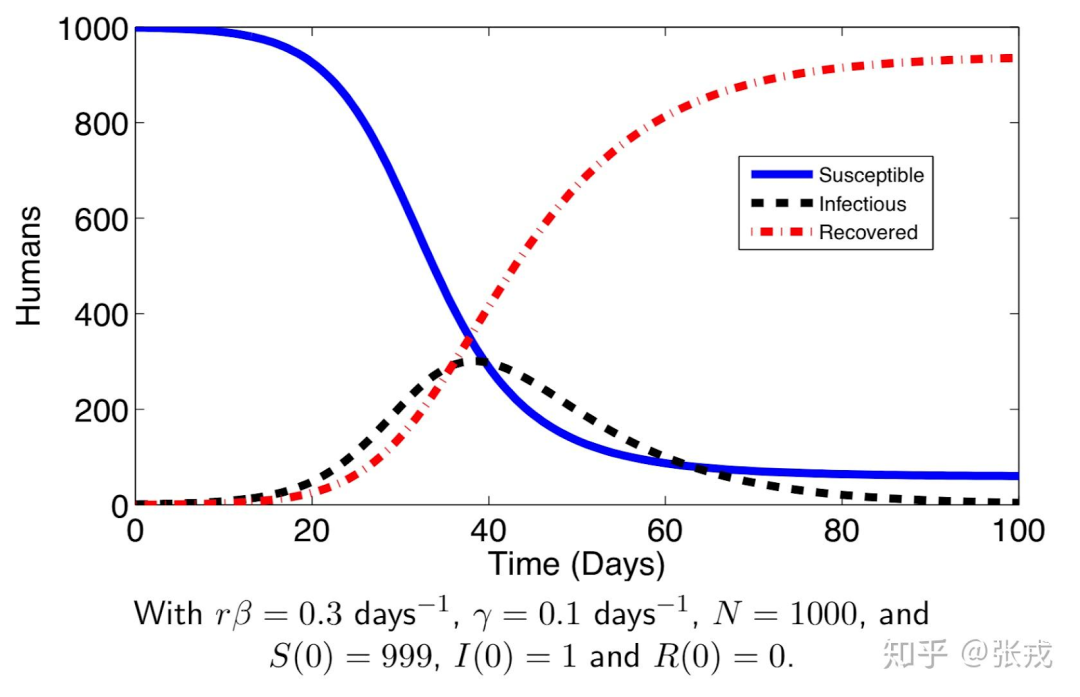
Source: https://zhuanlan.zhihu.com/p/103974270

The dominant meme indicators have strong guiding significance, not only helping individual traders judge whether the meme can successfully spread and at what stage of its lifecycle, but also assisting project teams in creating more mainstream MEMEs.
From the perspective of biological evolution, Dawkins (1998) proposed three indicators for measuring successful memes:
- Copying-fidelity: The more faithful a copy is to the original, the more likely it is to retain its intrinsic characteristics after several rounds of replication.
- Fecundity: The faster the replication speed, the wider the spread of the copies.
- Longevity: The longer the survival time of the replicating template, the more copies derived from it.
Successful memes need to have all three. The reason why dominant memes can spread widely is largely because they are easy to remember, not because they are important or useful. Therefore, effective memes should be those that can evoke highly authentic and long-lasting memories.
From the perspective of communication studies, Heylighen specifically described 10 selection criteria such as coherence, novelty, and simplicity, and designed a simple formula for meme fitness.
F(m) = A(m) x R(m) x E(m) x T(m)
F(m) represents the ratio of the average number of MEMEs in a time unit t to the average number of MEMEs in the previous time unit t-1.
A(m) represents the ratio of assimilation rates between the previous and current moments; R(m) represents the maximum retention time ratio of assimilated MEMEs between the previous and current moments; E(m) represents the ratio of the number of times a MEMEs is expressed and retained by the host between the previous and current moments; T(m) represents the ratio of the number of times a MEMEs is replicated and expressed to the host between the previous and current moments.
For a specific moment, A ≤ 1, R ≤ 1, while E has no upper limit and can be expressed 10, 20, or even hundreds of times; T also has no upper limit, and if broadcasted to, for example, ten thousand listeners, it is equivalent to replicating the MEMEs ten thousand times each time. In the formula above, if any factor is zero, the product must be zero. To make the fitness F>1, one strategy is to make E>1 or T>1.
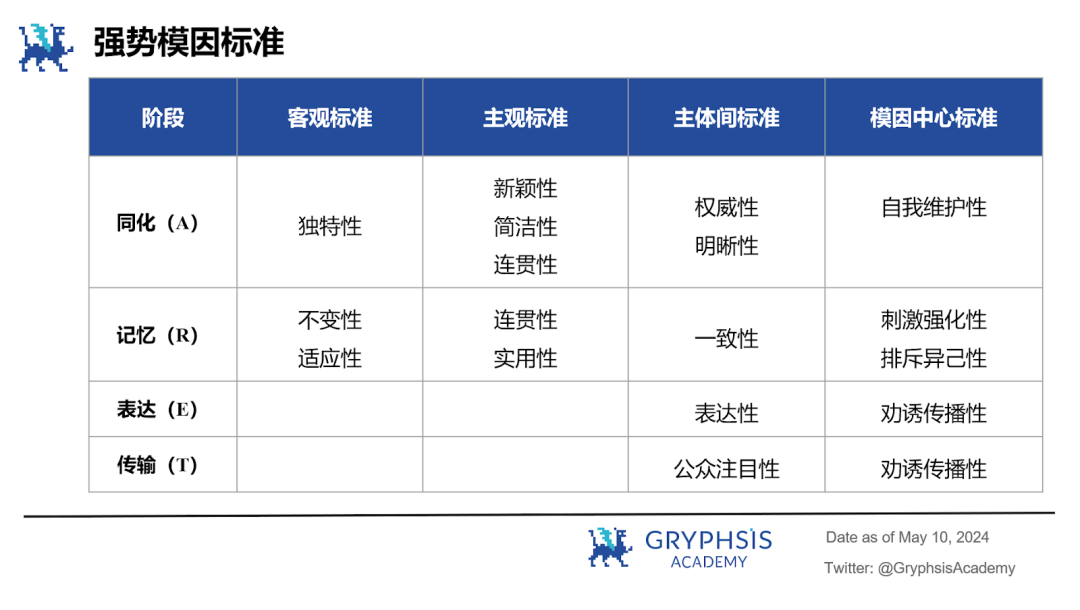
By observing the spread trends of most memes and conducting rough statistics, Heylighen's research found that if a model meets certain criteria in the table above, it is possible to successfully achieve the lifecycle of a meme, thus leading to replication and becoming a dominant meme.
However, whether from the perspective of communication studies or biological evolution, it is difficult to accurately judge to what extent a meme meets the criteria for being a dominant meme. From the perspective of finance and mathematics, the success rate of secondary trading indicators in judging MEMEs is about 30%, with a certain margin of error. Liquidity, the proportion of the top ten holdings, and the number of times the project team "Rugs" will also affect the measurement of MEMEs, but it is difficult to accurately quantify these indicators. Combining AI large-scale model analysis may be helpful.

Since the birth of Bitcoin, MEMEs have existed in every cycle and have performed well. From Litecoin to Dogecoin, and then to NFT and zoo MEMEs, MEMEs have been presented in various ways, with different characteristics and mechanisms as the cycle changes. Reviewing their development and current status can help better discover the answers.

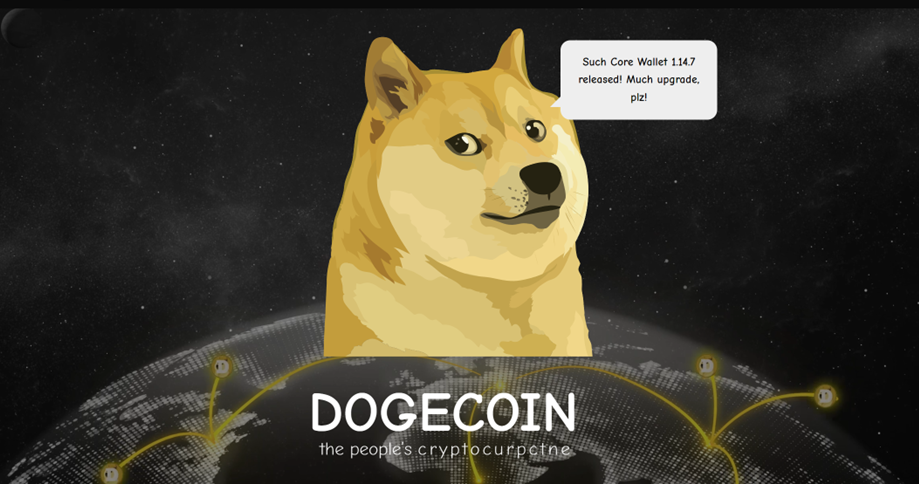
Source: https://dogecoin.com
The concept of MEMEs did not cause a market frenzy at the beginning, until 2013 when Dogecoin (DOGE) entered the public eye.
Doge is a MEMEs featuring a Japanese Shiba Inu, which originated from a picture of the Shiba Inu Kabosu that appeared in 2010. After Billy and Jackson launched Dogecoin (DOGE), it gained widespread attention on websites like Reddit and was used as a currency for tipping. Two weeks after its creation, the daily trading volume exceeded that of Bitcoin.
In 2014, Doge was chosen as the "Time" magazine's annual best MEMEs and appeared in mainstream culture. In 2021, with multiple pushes from Elon Musk, the price of Dogecoin (DOGE) skyrocketed. The success of Dogecoin (DOGE) laid the foundation for the prosperity of MEMEs and brought about new currencies. These new currencies were initially launched on the "Alternative Cryptocurrency" sub-forum of Bitcointalk using proof of work (PoW).
Subsequently, different MEMEs emerged in each period. Looking back at the ICO boom in 2017, most projects provided detailed whitepapers to attract investment based on technological innovation. During this period, most MEMEs were more serious, with visions hoping to go beyond MEMEs and make practical innovations.
During the DeFi boom, projects focused more on explaining their economic and liquidity advantages to attract participants. MEMEs at that time mainly featured animals and food. In addition, NFT projects were also considered MEMEs in the early stages. Some of the most representative NFTs include: CryptoPunks, Bored Apes, Pudgy Penguins, and others.
The current MEMEs trend relies more on emotional drive. Projects are no longer pursuing technological innovation, but are more focused on narrative direction and market hotspots. This phenomenon may reflect a certain degree of market fatigue, as investors, after experiencing a long period of technological orientation, are gradually seeking more IQ50 ways to participate in the market. In this mode, Pump has risen, attracting a large number of players in a low-cost manner.
Tracing the development of MEMEs, the characteristics of MEMEs can reflect the attitudes of investors at different times and current market hotspots. MEMEs include prospects for current new technologies and capturing hotspots.

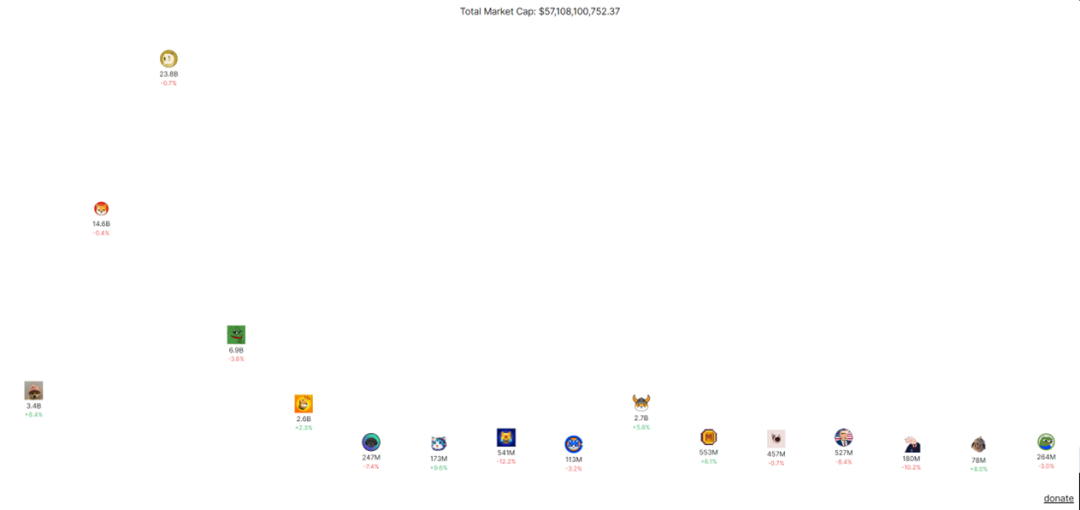
Source: https://www.MEMEsrace.xyz/
MEMEs can bring prosperity to public chains. From Doge to Bome, MEMEs have become a unique cultural symbol and communication method in Web3. Major public chains all have a place for MEMEs.
Currently, some of the high market value MEMEs are mainly deployed on chains such as Ethereum, Solana, Base, and Bitcoin (BRC20, etc.).
Among the top 500 market value MEMEs, the majority are deployed on Ethereum and Solana chains. This reflects the prosperity of the MEMEs ecosystem on the Solana chain in this bull market. In terms of the types of MEMEs that have emerged, the reason for the rise of the head MEMEs on the Ethereum chain is still early narrative logic, as most of them are early MEMEs such as PEPE and SHIB.
In addition to DOGE, the types of animal MEMEs on the Solana chain are more diverse, and their gameplay is more susceptible to market sentiment due to the emergence of BOME. MEMEs on the Base chain tend to capture technological trends and revolve around social ecosystems.
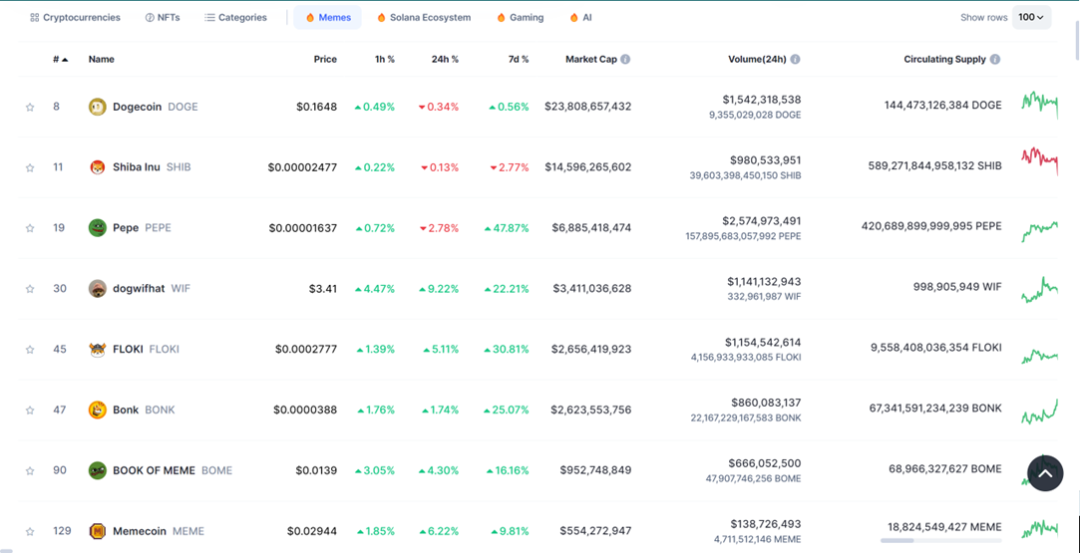
Source: Coinmarketcap
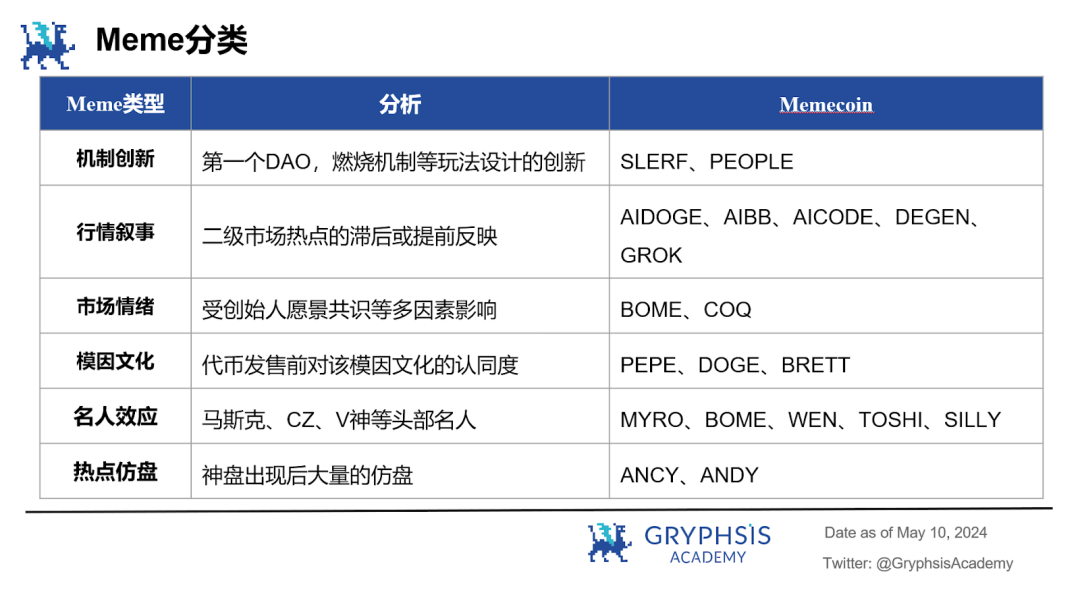
Innovative advantages of gameplay mechanisms
Representative cases include PEOPLE and SLERF. In Web3, consensus is king, and MEMEs focus more on consensus. PEOPLE gathered nearly 20,000 people from around the world through a ConstitutionDAO, which was a deep experiment of MEMEs on DAO at the time.
It was planned by innovators Graham Novak and Austin Cain, with the goal of auctioning off a printed copy of the 1787 U.S. Constitution, making it the first project to crowdfund for the protection of world historical documents, and achieving a hundredfold return at the time. SLERF, on the other hand, caused a sensation due to the project team's operational mistakes, forcing the founder to repay, and achieved a completely fair sale, sparking a craze.
Capturing the direction of market narratives
There is a certain time difference between the primary and secondary markets. MEMEs themselves can reflect the pursuit of new technologies. When the narrative in the secondary market is about AI, AI MEMEs also quickly rise, such as AIDOGE and AIBB.
In addition, holidays such as International Women's Day and the Spring Festival can also cause increases in related tokens like LADYS. Events such as the NVIDIA conference and CZ's court appearance can also trigger the issuance and fluctuations of tokens like NVEDUA and FREECZ, although most of these MEMEs quickly return to zero after the events end.
Elusive market sentiment
This type is difficult to judge, but most of them trigger consensus and ignite market enthusiasm. For example, the actions of the founder of BOME, Jia Yueting, quickly ignited the market.
Dominant meme culture
DOGE was all the rage before the token was issued, and PEPE's memes were widely spread before the token was issued. These are examples of strong memes preceding the appearance of tokens. Additionally, memes with artistic features tend to be more dominant, possibly because art inherently has more uniqueness in the assimilation phase.
Influence of celebrity effect
Elon Musk's endorsement of Dogecoin sparked "DOGE to the moon." Anatoly Yakovenko, the founder of Solana, launched SILLY during Halloween, which performed extremely well. In less than two weeks after its launch, its market value reached 70 million USD, with over 8,600 holding addresses and a high on-chain liquidity pool of 1.2 million USD. Due to the summer Olympics, national tokens also emerged, and when Musk mentioned Argentina in a tweet, smart money immediately noticed and bought in, earning huge profits.
Related hotplate imitations
This type mostly rides the hype of the hotplate, making it difficult to produce a true hotplate, but there is speculative space in the short term.
Only when the above conditions are met can a MEME become dominant. Although MEMEs may seem like a game for the masses, they still require a highly developed market sense.

The emergence and existence of MEMEs are influenced by society, psychology, economics, and technology. The reasons why MEMEs have received so much attention in this bull market can be briefly interpreted as follows.
Demand for mainstream narratives. Analyzing this bull market, it can be seen that the market lacks a mainstream narrative that can match the popularity of Bitcoin ETFs. The rise of value coins is not as satisfactory, while BOME was listed on Binance within three days. MEMEs can to some extent sustain the enthusiasm of crypto players and become a potential theme.
Improvement of infrastructure. The development of decentralized exchanges and the continuous improvement of public chain performance have greatly reduced the cost of token issuance and player participation.
Support from official public chains. Public chains have further attracted a large number of active users through the wealth effect of MEMEs, increasing their visibility and expanding their ecosystems. However, this has also brought about many negative impressions due to the wild growth, with the Solana chain cooling off MEMEs and the BASE chain choosing to support them, revealing the different development stages and strategies of the two public chains.
Alignment with consensus principles. The rise of MEMEs is closely related to Fair Launch. This fair distribution method is more in line with the values of Web3.
Market FOMO sentiment. Hype on social media and highly shareable images attract user participation. This FOMO sentiment is accompanied by retail investors venting their dissatisfaction with institutions.
Impact of wealth creation. The legend of overnight wealth creation has spread widely in MEMEs, attracting countless players. Additionally, MEMEs are simple and easy to understand, requiring no knowledge of complex technical principles, further lowering the barrier to entry for players.
A bull market with no handover. This bull market is one with no handover, and MEMEs are a mismatch of funds on a time scale, more in line with the narrative and psychology of retail investors.
MEMEs have revealed the primitive and wild nature of the unregulated financial forest and face many problems. However, as a cultural phenomenon and a popular investment, MEMEs have become an integral part of the crypto market. In the face of a complex market environment, it is important to understand that profits are a reward for good risk management, and relying on luck-based bets will ultimately fail in the market.

To date, the gameplay mechanisms of MEMEs have become more diverse. Some have made substantial profits, but most players end up with losses. MEMEs are not just a game of luck; mastering a good strategy is the only way to profit in the harsh financial market.

On-chain trading prioritizes security. When interacting on-chain, it is crucial to focus on the security of wallets and contracts. There are currently many tools that support the detection of contract security, and some basic market-watching applications integrate these functions. In addition, it is important to guard against project team "Rugs," false positives about burning pools, and other risks.
Early MEMEs gameplay focused on discovering early Alphas. The issuance and user participation costs were relatively high, and players mainly focused on increasing their win rates. Basic judgments could be made by observing the size of the pool, market value, liquidity, and the top 10 holdings, combined with Twitter followers, community heat, and website completion for comprehensive analysis.
With the rise of MEMEs on the Solana chain, the gameplay has become more diverse, and metrics such as Twitter followers and community heat cannot be used as single evaluation indicators. Additionally, MEMEs trading has a faster pace, with a high frequency of issuance, leading to a resurgence in the trading bot market due to MEMEs.
As Pump continues to be popular, hotspots such as national coins, fruit coins, vegetable coins, and TRUMP have emerged one after another, with rapid conversion speeds. The rise of MEMEs has also had a certain impact on the activity of Tg Bots.
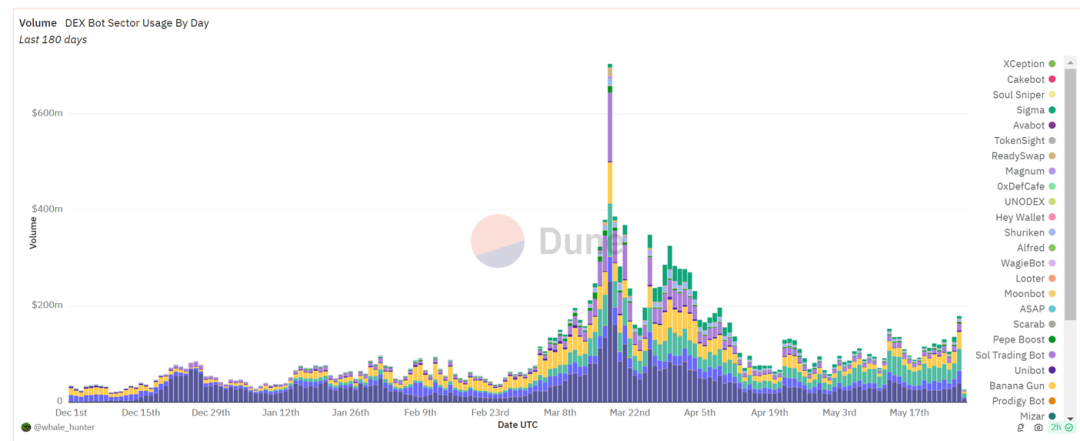
Source: Dune (@whale_hunter)

Pump, as a platform focused on creating and trading MEMEs on Solana and Blast, continues to gain popularity. The popularity of Pump's gameplay reflects the project's need for quick token issuance and the players' demand for social interaction to some extent.
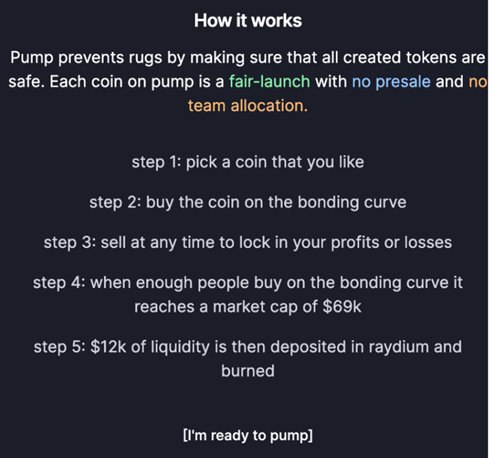
Source: Pump
Pump currently uses a bonded curve mechanism as a DEX. Compared to AMM, it is more suitable for the issuance and trading of new tokens, directly linking token prices to supply through a mathematical function, without relying on two assets in a liquidity pool.
Issuing or trading on Pump is very simple. When the market value of MEMEs reaches 69K, the platform automatically deposits 12K liquidity into decentralized exchanges (such as Raydium) and executes a burning mechanism to stabilize the token price and increase scarcity.
The extremely low participation costs of Pump have attracted a large number of players, with substantial profits, generating daily income of over 400,000 USD. However, the platform lacks technological barriers and currently relies solely on scarcity for profitability.
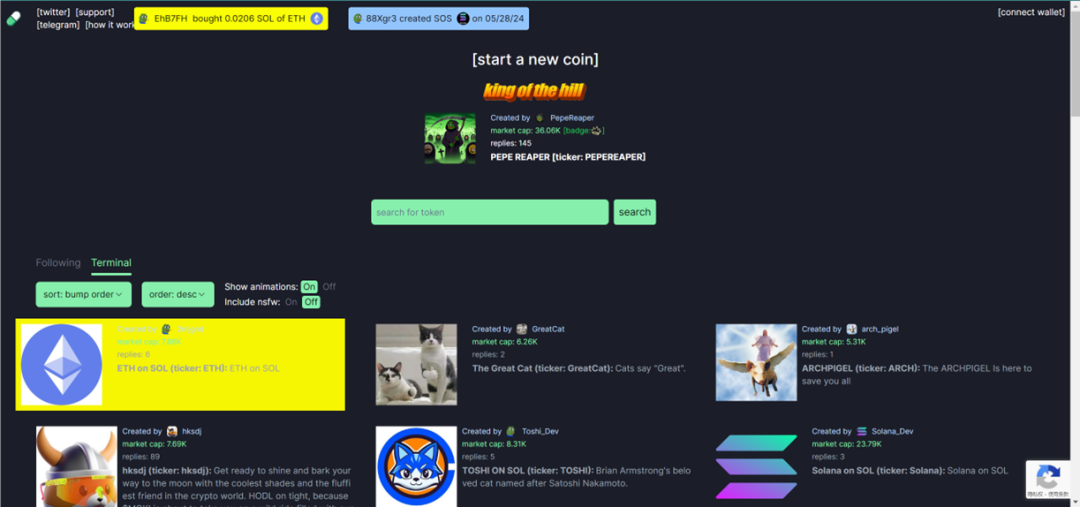
Source: Pump
Pump's simple yet highly addictive interface facilitates rapid changes in hotspots. MEMEs such as Michi (michi), USA (American Coin), and SC (Shark Cat) have all appeared on Pump. The wealth effect on the platform has attracted many players to participate.

MEMEs can be traded using various metrics, but there is no golden indicator. Metrics with a strong adherence to frameworks may increase win rates, but could also lead to missing out on golden opportunities.
Trading strategies driven by public sentiment. Judging the degree of FOMO at various stages of the dissemination chain. In the actual process, a high level of sensitivity, as well as a high-quality community and KOL list, are required.
Technology-centric trading strategies. Signal trading and on-chain data analysis are used in parallel with robot tools. These include several strategies: smart money tracking, suitable for trading in major market movements. However, personal investment strategies can be formed based on the trading style of smart money. Scientist sniping requires establishing selection criteria for targets and using robots to assist in trading. Strict execution of strategies by robots can significantly increase win rates but may lead to missing out on golden opportunities.
Financial mathematics-based trading strategies. Mainly based on candlestick charts, chip distribution, etc., for judgment. Different pool sizes, fund volumes, and gameplay require different strategies. Common strategies include: daily players, typically participating in medium-sized pools to ensure that the project does not rug overnight. Long-term holding or swing trading. Ultra-short-term players mainly observe candlestick charts, target quality, etc., to participate. With the popularity of Pump, some players have early positions in hotspots and trade through Pump's internal market.
Risk Warning: Participation in MEMEs carries extremely high risks and could result in the loss of the entire principal.


MEMEs have attracted significant attention in this bull market. Various institutions have different views, with MEMEs vs. value coins becoming a hot topic of discussion in this cycle.
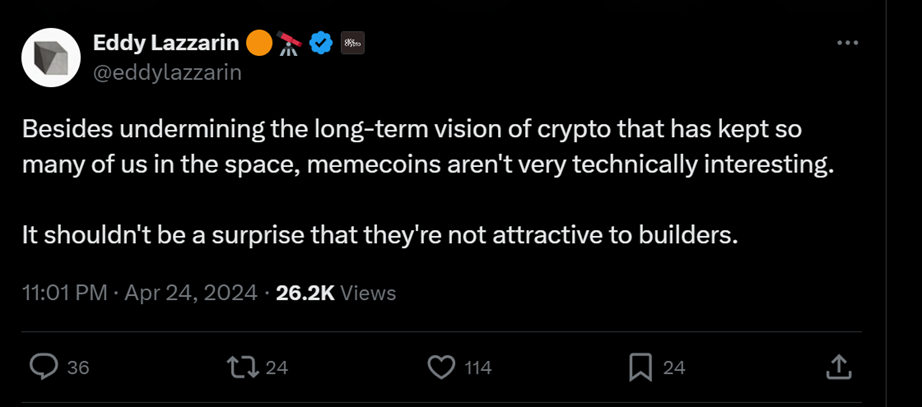
Source: https://x.com/eddylazzarin/status/1783149288471617661
A16Z CTO has explicitly criticized MEMEs, stating that "MEMEs disrupt the long-term vision that keeps many people in the crypto field and are not attractive from a technological standpoint; they are not appealing to builders." However, according to on-chain address data compiled by Scopechat and Rootdata, the largest holdings in A16Z's public address are Uni, followed by COMP and ETH.
But many institutions and KOLs have a positive attitude towards MEMEs. A partner at Pantera believes that MEMEs, as an interesting social activity, can attract more people to join Web3 at a low threshold and serve as an entry point for the early ecosystem of public chains, allowing the next generation to experience the latest DeFi applications and introduce them to Web3. Additionally, MEMEs can further enhance the development of applications such as NFT projects and social protocols.
V God also has expectations for the future of MEMEs, stating that MEMEs should be fun and meaningful, not just speculative tools. He believes that MEMEs can further develop in charity and Robin Hood games. In fact, as the largest MEMEs, Dogecoin has always been committed to charity, supporting the Jamaican bobsled team at the Sochi Winter Olympics, building clean water wells in Kenya, and planning to remove 30 million pounds of garbage from the ocean.

MEMEs have been highly controversial in this bull market, due to the gap between the true value of MEMEs and their current market value. However, it is still difficult to reach a consensus on how to define a high-quality MEMEs and what kind of project qualifies as a high-quality MEMEs at this stage.
Bitcoin, as the biggest meme coin in Web2, who were the initial buyers - the gamblers seeking to get rich quick, or the investors in blockchain consensus? Will the lawless financial jungle eventually give birth to MEMEs under the consensus of capital, or will it track the meme coins of equality and freedom? It's worth looking forward to.
Finally, before learning to construct, do not take apart what has been deconstructed as the final answer to the problem.
References
[1] Richard Dawkins. The Selfish Gene. Lu Yunzhong, Trans. Beijing: CITIC Press, 2019:224.
[2] Susan Blackmore. The Meme Machine. Gao Shenchun, et al., Trans. Changchun: Jilin People's Publishing House, 2011:25.
[3] Lv Peng, Zhang Haopeng. Research on Internet Memes: Concept Definition, Theoretical Practice, and Value Enlightenment. Foreign Social Sciences Front, 2023(02):18-46.
[4] Yue Xue. Research on the Non-terminological Phenomenon and Its Process of Terms from the Perspective of Meme Theory. Master's thesis, Northeast Normal University, 2012.
[5] Sha Deyu. On the Theoretical and Practical Value of Memetics. Master's thesis, Fujian Normal University, 2007.
[6] https://foresightnews.pro/article/detail/57407
[7] https://www.theblockbeats.info/news/53261
[8] https://vitalik.eth.limo/general/2024/03/29/memecoins.html
[9] https://www.techflowpost.com/article/detail_17708.html
免责声明:本文章仅代表作者个人观点,不代表本平台的立场和观点。本文章仅供信息分享,不构成对任何人的任何投资建议。用户与作者之间的任何争议,与本平台无关。如网页中刊载的文章或图片涉及侵权,请提供相关的权利证明和身份证明发送邮件到support@aicoin.com,本平台相关工作人员将会进行核查。




